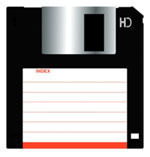Floppy Disk
A floppy disk is a non-volatile, magnetic storage device that can be read and written to by a floppy disk drive. Floppy disks were once the most infamous form of storage and were used to store a wide variety of files, including executable files, text files, and small audio clips. Before the advent of the personal hard drive, programs were separated into dozens of small files and stored on floppy disks, which would then have to be inserted one after another into a computer in order for a program to work. While floppy disks are rarely used in the modern world, they are still manufactured, distributed, and used for some applications.
How A Floppy Disk Works
A floppy disk consists of magnetic tape that contains information, which is surrounded by a thin coat of fabric which removes dust, and a layer of plastic to protect the interior components. Floppy disks are very flimsy and lightweight, but do not require a power source in order to store information. Floppy disks were essentially the forerunner to flash media devices, but were only able to store 1.44 MB even in their best days.
Applications
Although floppy disks are rarely used anymore due to the affordability and abundance of flash media devices, such as USB-based thumb drives, external hard drives, and SDHC cards, they are still used for backups, transferring small numbers of data from one location to another, and for booting aging hardware that is no longer able to support booting from other media. Additionally, floppy disks are used for updating BIOS information and performing recovery operations in the event of a BIOS failure.



Comments - No Responses to “Floppy Disk”
Sorry but comments are closed at this time.